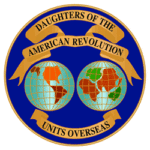We are the Palatinate Chapter of the National Society Daughters of the American Revolution (NSDAR, DAR). Our chapter was founded on April 15th, 2000 in Ramstein, Germany.



Germany
We are the Palatinate Chapter of the National Society Daughters of the American Revolution (NSDAR, DAR). Our chapter was founded on April 15th, 2000 in Ramstein, Germany.


The DAR is a women’s service organization dedicated to promoting historic preservation, education, patriotism and honoring the patriots of the American Revolutionary War.
What we do:
Our Friends:
Our Sister Chapters:
List of our Members’ Patriot Ancestors
Why did we choose the name “Palatinate” for our chapter?
Our chapter name originates in ancient Rome. According to legend, Romulus and Remus, the founders of Rome, were raised in the cave of a wolf on the Palatine Hill, one of Rome’s famous seven hills. Later the Palatine became home to some of Rome’s notables including the orator, Cicero, and several Emperors whose magnificent dwellings led to our present word “palace.” Eventually certain Roman officials were given the title “Palatine” when they represented the emperor in far off regions of the empire.
The Germanic emperors and kingsmedieval Europe continued to use this title. As these rulers traveled about their realms, they needed someone in charge at their castles between visits. The Count Palatine (literally “of the palace”) began representing the absent King, and received administrative and judicial powers over the local inhabitants. Some of these counts became extremely powerful in their own right, such as the Count Palatine of the Rhine (Pfalzgraf) who was one of the electors of the Holy Roman Emperor. He controlled a large territory known as the Rhenish or Lower Palatinate which included land on both sides of the Rhine River. Heidelberg was its capital for many years.
In 1329 a portion of northeastern Bavaria came under the control of the Count Palatine. This was known as the Upper Palatinate (Oberpfalz) and bordered the present Czech Republic. Amberg was the capital and Regensburg eventually joined the territory. Boundaries were rather fluid in those days as kings, bishops, and knights played in a grand chess game of alliances and disputes. The Rhenish Palatinate flourished in the 15th and 16th centuries and Heidelberg was an important political and cultural center during the German Renaissance and Reformation. At one time the Palatinate was one of the strongest powers in the German Empire.


|
In 1610, the young Friedrich V became the Elector (Kurfürst) of the Palatinate. In 1613, he took as his bride, Elizabeth Stuart, the eldest daughter of England’s James I.
|
Legend recounts that the festivities in honor of their wedding in London included a performance of “The Tempest” with William Shakespeare taking the part of Prospero. The young couple themselves would be part of a real tragedy a few years later. A Protestant assembly in Bohemia deposed their Roman Catholic king in 1618 and offered the crown to Friedrich who eagerly accepted it. Unfortunately, Hapsburg forces had other plans and without the anticipated support from England and other Protestant factions, Friedrich not only lost Bohemia but his Palatinate territories as well. This was the beginning of the 30 Years War, a largely religious war. Catholic nations fought the growing power of the Protestant states. The area which makes up modern-day Germany was the scene of many horrendous battles, and some areas, such as the Palatinate, suffered the loss of a third of its population, as marauding troops brought destruction, starvation, and the plague. Agriculture and commerce were brought practically to a standstill. Finally it became clear that all were losers in this war, and, for the first time in European history, both sides agreed to sit down to treaty negotiations.
Five years of negotiation brought about the Treaty of Westphalia, signed in 1648, which established the principle of freedom of religion, laying important groundwork for the development of democracy. The Lower Palatinate was returned to Friedrich’s son, Karl Ludwig, who repopulated the Palatinate lands by inviting Protestant refugees from Switzerland, Tyrol, the Savoy, and the Netherlands to settle there.
(By the way, Friedrich’s daughter Sophie married into the family of the Elector of Hanover and her son became George I, King of England.)
Most people probably associate rose cultivation with England, but Germany also has a long history of rose-growing and a few interesting highlights that you can discover below.
European Rose Breeders Differentiate Between Garden and Cut-Flower Roses
Roses that are grown in the United States are primarily long-stem varieties used in bouquets.
Many European rose-breeding firms strictly separate their garden rose lines from their cut-flower varieties. Some of the leading European rose producers include Kordes and Söhne in Hamburg, Delbard in France and Peter Beale Roses in the UK.
European rose growers tend not to use chemicals in the breeding process. Traditionally the US did use chemicals, but the use has declined in recent years. As chemical use declined, many US rose varieties began to flounder, developing blight and other illnesses. Roses came to be known as ‘fussy’ and US gardeners increasingly turned to traditional European varieties because they were said to be more disease resistant and easier to grow. Today one of the most popular rose brands in the US is David Austin roses. Austin Roses are said to have led to the rebirth of garden roses as flowering shrubs in the United States.
The Thousand-year Rose of Hildesheim
The oldest known rosebush in the world is located in Hildesheim, Germany. It has been estimated to be around 700 years old and grows up the wall of the Hildesheim Cathedral, which has been a UNESCO World Heritage Site since 1985. A wild dog rose (Rosa Canina), it is growing up the apse of the church and is about 10 meters (33 feet) high. Even though the church was destroyed by allied bombers in WWII, the roots of the rose survived. According to legend, as long as the rose bush flourishes, so will the town of Hildesheim.

The 700 Year Old Dog Rose Bush on the Aspe of the Hildesheim Cathedral (Source: Wikipedia)
Wild dog roses have 20-30 species and subspecies which appear in a variety of shapes and colors. The Canina variety has pale pink, fragrant flowers and five to seven petals. The thorny stem helps it climb to a height of one to three meters, or in the case of the Hildesheim rose much higher with additional support. In the fall, the dog rose produces ‘hips’, often used in teas and homeopathic treatments.

Rose ‘Hips’ from the Dog Rose (Source: Wikipedia)
One legend says the dog rose was once a symbol for the old Saxon goddess Hulda. Hulda is depicted as a maiden in snow-white clothes and is associated with winter. When the deciduous dog rose loses its pale petals in the fall, it is said to remind one of the goddess Hulda shaking our her feather pillow. The legend is the basis of a well-known children’s fairytale in Germany.

Rosa Canina Flower (Source: Wikipedia)
Steinfurth: the German Roses Capitol
The Steinfurth area north of Frankfurt is famous for its half-timbered houses, monasteries, orchards…and roses! Steinfurth is the rose-growing capitol of Germany with thirty nurseries that produce about fourteen million roses a year. On a breezy summer day, they say you can smell the perfume from the flowers before you reach the town. The industry was founded in the late 1860’s by a young German who had done an apprenticeship in England. Steinfurth celebrates its most well-known industry with a festival every summer and a museum dedicated to the history of the roses.
Have a wonderful summer!
Sources:
Most people probably associate rose cultivation with England, but Germany also has a long history of rose-growing and a few interesting highlights that you can discover below. European Rose Breeders Differentiate Between Garden and Cut-Flower Roses Roses that are grown in the United States are primarily long-stem varieties used in bouquets. Many European rose-breeding firms …
April, 2024 marks the 300th birthday of German political and moral philosopher Immanuel Kant (22 April, 1724-12 February, 1804). He is considered one of the most influential thinkers and political philosophers of the Enlightenment era. Portrait of Kant from the Smithsonian Institute Kant’s Life and Work Immanuel Kant was born in Königsberg, Prussia, which …
Continue reading “German Philosopher Immanuel Kant and his Influence on Early America”
In an age where sustainable lifestyle is on the tip of everyone’s tongue, perhaps there are some useful ideas from Germany about how we view our forests and their role in contributing to keeping the world climate in balance. How Important are Trees in Germany? There are over 90 billion trees that cover one-third of …
Membership Information: Karen Rink
Associate Membership Information: Pam Jensen
DAR Associate Renewal Form 2023:2023-24 Associates Form_Fillable
Webmaster: Emily Ryan
Palatinate Chapter Officers (2023-2024)